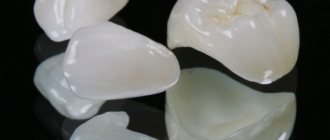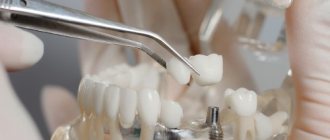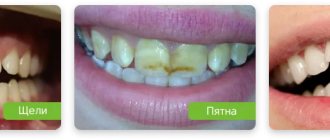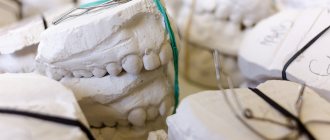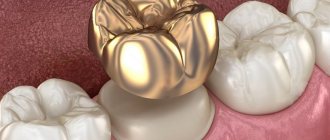Porcelain crowns are the best option for tooth replacement in terms of aesthetics
Article navigation
- Porcelain: material features
- Indications and contraindications
- Types of porcelain crowns
- Advantages and disadvantages of the material
- Porcelain crowns: the process of creation and installation
- How to fix the product
- Care rules for long-term use of dentures
- Life time
- Comparison of porcelain with other materials
- Price issue
Question for a specialist
Teeth are one of the strongest parts of our body, but, nevertheless, they are not immune from the negative effects of the food we eat, the lifestyle we lead, and the environment. They grow twice, in the milk and permanent dentition, and if we fail to maintain their original shape, color, functionality, then we have to find ways to correct the situation. Fortunately, today prosthetic technology is experiencing its heyday, and restoring damaged or destroyed teeth is not a problem. Today, attractive porcelain crowns, for example, are in increasing demand. Let's look at the features of this material and the stages of manufacturing structures based on it in detail.
Who should not get veneers?
Not everyone can get veneers. There are some contraindications:
- If teeth are affected by caries, veneers can be installed only after appropriate treatment. The same applies to periodontitis.
- The patient is missing a significant part of the tooth.
- Thin or worn enamel.
- The patient suffers from bruxism.
Bruxism is periodic paroxysmal contractions of the masticatory muscles during sleep, accompanied by clenching of the jaws and grinding of teeth.
Porcelain: material features
Today, porcelain, first used in prosthetics just over two centuries ago, is considered the most popular material. Crowns made from it are essentially a ceramic product without metal impurities in the composition. The product is produced by processing ceramic mass at high temperatures. The complexity of the manufacturing process of porcelain structures determines their high qualities - wear resistance, precision fit, high aesthetics. They are easy to install, hypoallergenic, and serve their owner for many years, maintaining their original color and shape.
This is interesting! It is believed that the first dentures with a porcelain component appeared about three centuries ago. Orthodontist Pierre Fauchard sharpened crowns from durable ivory, additionally strengthening them with a layer of gold. To make the structure look aesthetically pleasing, he made the top covering from a thin layer of ceramic to match the adjacent units. It was only towards the end of the 19th century that the technology of firing a porcelain crown on platinum foil appeared.
It is important to understand that porcelain and ceramics are actually the same thing. Porcelain is a type of ceramic, one of its highest quality types, since it has a snow-white color even from the inside, i.e. in cross-section, as well as high strength characteristics. But in dentistry there is no division as such into “porcelain” and “ceramics”, so crowns are generally called ceramic, even though there are varieties (pressed ceramics, regular or even with the addition of a composite).
Preparation before production
To ensure a harmonious combination of the crown with other organs of the dentition, the doctor takes a combined impression.
After preparing the stump, a copper ring is placed on it, which is pre-filled with a special mass. While it is in the oral cavity, an impression of the entire dentition is taken. A plaster model is cast on it.
It is necessary that the cast of the stump be inserted and removed well into it. Thanks to this, it is possible to produce a high-quality porcelain crown.
Indications and contraindications
Porcelain structures are an excellent choice in many problematic situations. Here is a list of indications for their installation:
- allergies to plastic or metal: porcelain crowns are absolutely compatible with oral tissues, they are hypoallergenic,
- ideal restoration of the smile area: porcelain has excellent light transmission and perfectly matches the natural shade of the enamel, which allows you to make the prosthesis very aesthetic and hide its presence from others (it will not stand out against the background of neighboring teeth),
- the need to restore teeth severely damaged by caries or other dental diseases,
- the need to restore teeth that have fluorosis, hypoplasia, a wedge-shaped defect: in this case, prosthetics with crowns are resorted to if it is not possible to correct the defect by other methods (for example, whitening),
- the need to adjust the shape and position of the tooth: crowns can be used only if there is slight curvature or deviation from the norm, otherwise the patient may be recommended to wear braces.
Contraindications to the installation of these orthopedic products should also be taken into account. Limitations include serious malocclusion, bruxism, and various inflammatory processes in the oral cavity in the acute stage. First, you need to eliminate the existing problems in the doctor’s chair, and only then can you begin prosthetics.
Advantages and disadvantages
The main positive aspects of using porcelain crowns in dental prosthetics include their complete identity with natural human teeth. Due to their hardness and excellent appearance, they are quite popular among visitors to dental offices. At the same time, analyzing the positive and negative aspects of these crowns, one cannot fail to mention a number of disadvantages:
- the inherent fragility of ceramics;
- insufficiently tight fit to the gum and tooth;
- high degree of abrasiveness, which affects the contacting teeth;
- the relative high cost of such artificial teeth compared to polymer and metal ones.
The lack of an ideal fit at the attachment points forces dentists to operate on a larger area in the patient’s oral cavity; in addition, deterioration in the strength of the attachment can correspondingly affect articulatory properties.
Types of porcelain crowns
The types of porcelain dentures are determined by their location in the oral cavity - in the front (frontal smile zone) or on the side. In addition, such prostheses can be made from various types of materials.
Made from classic ceramics
Such crowns are made of classic ceramics or porcelain. They are distinguished by high aesthetics and fairly good strength. They are placed mainly on the front teeth, since this is where the appearance is most important, while the chewing load is reduced to a minimum - that is, the risk of product breakage is reduced.
Made from pressed ceramic
In fact, it is lithium silicate, which today is commonly called glass ceramics. There are no pores in it, so the aesthetics of the finished product remains at the same high level, but at the same time the strength characteristics increase significantly. This category includes IPS brand materials (e.max and Empress), which are most popular in the dental market today.
On a note! Very often, ceramic crowns include products made from zirconium dioxide (or oxide). Unlike zirconium, it is not a metal, but simply an element or material that is completely incorrect to call ceramics. In general, ceramic or porcelain or zirconium dioxide crowns constitute a group of metal-free products – this is already the correct name.
What is better to choose for veneers – porcelain or ceramics, how they differ and how much they cost
Article navigation
- How are veneers different from crowns?
- Indications
- Ceramic or porcelain?
- Ceramic - made from powder or liquid
- Glass ceramics
- How do they compare favorably
- Overlays
- Zirconium oxide and aluminum veneers
- Composite veneers
- Material
- Veneer color
- Size and shape
- What do dentists recommend?
Question for a specialist
Veneers are one of the methods of microdental prosthetics, which involves restoring the aesthetics of a smile. Veneers are thin, permanent plates that are fixed to the front surface of the teeth, allowing them to be aligned and changed color. There is a lot of controversy around such microprostheses today - some doctors recommend them as the most acceptable option for restoring aesthetics, others oppose their astronomical cost. What is it, and which veneers are better - porcelain or ceramic? What are they made of, and are these dentures really a panacea for patients who want to have a “Hollywood smile”? We'll talk about all this further.
Advantages and disadvantages of the material
It is no coincidence that Europeans call special dental porcelain an enamel substitute. Prostheses made from it not only perfectly replicate the anatomical features and shade of the original units, but they are also smooth, translucent, and have a mirror-like shine. Exactly like enamel. Porcelain teeth, if they are truly made with high quality, cannot be distinguished from natural ones. Therefore, the material is often chosen for prosthetics of the front teeth - those that are located and clearly visible in the “smile zone”.
Complex on 4 OSSTEM implants with delayed loading - from RUB 170,000.
Complex implantation Osstem (South Korea) with delayed loading after 4-6 months.
Guarantee for the doctor’s work - unlimited Call now or order a call
Opening hours: 24 hours a day - seven days a week
In addition, they are quite durable and resistant to chips, and perfectly retain their original shade even when exposed to coloring pigments from food. With proper installation and high-quality oral care (regular hygiene, professional cleanings, avoiding combining hot and cold foods), porcelain products will delight you with their shine, stable shade and shape for about 10-15 years.
And if you have long dreamed of a flawless smile, then porcelain crowns are a great way to achieve it. Installation is quick, the designs are well suited for allergy sufferers who may react to polymers or metal. Products made from pressed ceramics are very light, and you get used to them quickly.
However, this modern aesthetic material has its drawbacks. Due to its fragility, the material does not allow the manufacture of bridge structures. Only single restorations are made from it. And the production of porcelain dentures itself is expensive, which affects the final cost of the product. Especially if the choice fell on modern pressed ceramics.
Interesting! The very first known dentures, as archaeologists testify, were allegedly made from the teeth of wolves and other wild animals. The artifacts were found in Mexico and date back to 2500 BC. Later, dentures were made from the shells of sea creatures and were fixed in the mouth with gold rings. Until the middle of the 18th century, dentures were made from ivory and the teeth of various animals.
Indications for installation
to resort to installing veneers if the tooth has a crack or a pronounced chip, a congenital or acquired uneven surface. Fillings that, during use, for some reason, have changed their original color are another reason for the installation of veneers.
You can often find congenital anatomical features that have a negative aesthetic effect. For example, large interdental spaces, crooked rows, uneven arrangement of teeth on the jaw, etc.
Also, as a result of any previous diseases or the use of certain medications, permanent stains may form on the tooth enamel. In this case, an effective way to restore the original aesthetic appeal is also to install porcelain veneers.
Porcelain crowns: the process of creation and installation
The process of creating porcelain dentures is quite labor-intensive. It consists of two stages.
Preparatory stage
At this stage, the doctor determines the condition of the tooth that will need to be restored. The specialist also sanitizes the oral cavity and performs therapeutic procedures. Next, the doctor begins to work with the tooth on which a ceramic prosthesis will be installed. It is advisable to remove the nerve from it to protect it from further inflammation under the crown.
If there is nothing left from the top of the tooth, it will not be possible to fix the crown - you must first build up the tooth. For this, pins or stump inlays are used (the first option is universal, the second is individual, laboratory). If the crown remains, then it is given the shape of a cone. Pure ceramics are quite thin, so little living tissue is ground away - a layer of hard tissue will need to be removed from the prepared unit to form a ledge 0.8 to 1.5 mm wide. It is this thickness of the walls of the future porcelain crown that ensures the strength of the product. The prepared apex becomes like a cylinder or a truncated cone.
Next, the orthopedist makes several impressions or impressions of the prosthetic area and the entire jaw. And selects the shade of the future artificial unit. The data obtained will be sent to the dental laboratory, where the prosthetic structure will be manufactured. Take this period up to a couple of weeks. During this period of time, the doctor will install a protective temporary plastic structure on the prepared tooth.
Laboratory stage
The technician, having received all the data from the orthopedist, begins making the crown. First, a model of the patient's jaw is cast based on the impressions. A cap made of platinum foil is placed on a specific tooth, which is filled with porcelain mass. Next, the product is double fired - inside and outside. The final stage is adjusting the size, giving the shape, the desired shade and glazing the resulting artificial tooth, final firing at a very high temperature - just under 1000°C.
On a note! Some ceramic materials (mostly pressed) are processed using CAD/CAM milling technology. That is, first a scan of the oral cavity or a finished model of the jaw is performed, the crown is created in a special program, and then turned on a robotic machine. Of course, this is more expensive for the patient, but it is more accurate, and the result is more predictable.
Installation of porcelain onlays
The patient comes to see the dentist, and together they select the optimal shape and color of the veneers. After the choice is made, the doctor pre-treats the teeth. A thin layer of enamel corresponding to the thickness of the plate is ground off from their front side. After this, the doctor makes an impression of the patient’s teeth, from which the onlays will be made. They can be made using a special apparatus or manually. Many dentists prefer products that are made by hand, considering them to be of higher quality.
Attention! The process of making the overlays takes about a week. Since the patient’s teeth have already been ground, the doctor puts a special protective structure on them.
After the veneers are ready, the patient comes for a fitting. If the onlays do not fit tightly to the tooth or fit poorly, they are sent for revision. If everything is fine, you can begin installation. First of all, the doctor etches the surface of the tooth with a special gel for good adhesion to the onlay. He applies a small amount of adhesive to the back of the veneer and then glues the veneer to the tooth. After that, he carefully examines whether she is sitting correctly. The final stage is irradiation of the tooth with a special lamp so that the composition hardens. Hardening occurs very quickly.
The initial stage of creating veneers is selecting a shape and color that will match the shape and color of natural teeth.
How to fix the product
The finished product must be tried on. The doctor evaluates how the prosthesis fits into the color range, checks the quality of the design, determines whether it interferes with the bite, whether it puts pressure on the adjacent tooth, or injures the mucous membrane. If the prosthesis needs adjustment, it is carried out. If everything is in perfect order, you can proceed to installing an artificial tooth - and here there are two options:
- fixation with temporary cement: the patient walks with a new artificial tooth for 2-3 weeks. During this period of time, it is important to determine the degree of comfort of the product, note all the sensations that arise and possible discomfort. If you fix the crown directly with permanent glue, you will no longer be able to correct the product,
- fastening with permanent cement: if the patient does not express any complaints, you can begin treating the crown with an antiseptic and fixing it to the stump. After this procedure, the structure is considered permanent; it cannot simply be pulled out of the mouth and adjusted.
What are porcelain veneers?
Like porcelain veneers, these are dental overlays made from a custom impression. Their thickness is comparable to the thickness of a contact lens - only 0.2–0.3 mm. Before installing lumineers, as they are also commonly called, it is necessary to cure caries, after which the doctor will take an impression and send it to the laboratory. There is no need to grind your teeth. This is the main advantage of the technology, because after removing veneers made from other materials, new ones must be installed. In this case, the integrity of the tooth remains intact.
Care rules for long-term use of dentures
In order for porcelain structures to serve you for a long time, it is important to treat them with care. By taking the following precautions, you will extend their life:
- Clean your mouth thoroughly after each meal - use an irrigator, rinse,
- do not use dental floss or brushes in the area of the installed crown - it can be damaged,
- Once every six months, carry out hygienic cleaning in the dentist’s chair: caries does not threaten the artificial tooth. However, the resulting plaque can penetrate under the gingival margin and destroy the root system of a living tooth,
- give preference to foods that are not very hard or particularly tough: also avoid eating too hot or too cold food and drinks at the same time (such temperature changes can negatively affect not only the enamel of living teeth, but also any artificial material),
- Give up bad habits: don’t snack on floss with restored (as well as natural) teeth, don’t open lids, don’t bite your nails.
Cost of installing veneers
The final cost will be calculated by your doctor after the first consultation. The examination, drawing up a treatment plan and cost estimate are free of charge. The price for installing veneers depends on the number of onlays and the need to pre-treat caries. X-ray diagnostics, taking impressions and computer modeling are paid separately.
Initial consultation
- Oral examination
- Making a treatment plan
- Drawing up a treatment estimate
For free
Cost of installing a veneer (1 tooth)
- Anesthesia and pain relief
- Modeling teeth on wax
- X-ray images
- Computer smile modeling
- Tooth treatment
- Taking impressions
- Making a veneer
- Veneer installation
The final cost depends on the material you choose
from RUB 20,990 to RUB 31,000
Production is kept secret and is carried out only in the Cerinate laboratory, which determines the considerable price of porcelain veneers - they are much more expensive than ceramic and composite ones. Ready-made onlays are placed on the teeth using super-strong cement. With proper care, they last up to 20 years.
Since lumineers are thin, they cannot mask serious imperfections or correct enamel color that is too dark. The installation technology without grinding is mainly suitable for patients with small teeth, because adding extra thickness can have a negative impact on aesthetics. Porcelain veneers are used for:
- enlarged spaces between teeth;
- small fillings, minor cracks and mild pigmentation on the enamel;
- the patient’s desire to lighten the shade of the enamel by 1–2 tones;
- presence of cracks and chips on old ceramic crowns.
Comparison of porcelain with other materials
To understand whether dental porcelain is right for you for dentures or not, look at its comparison with other materials.
Differences from plastic
Prostheses made of polymers are easier to process, and their installation is easier. However, plastic crowns lack such advantages of porcelain products as high aesthetics, hardness and preservation of the original shape, shade and transparency. In addition, they are porous, so they do not retain color for a long time - they can only be considered as a temporary option for restoring dental defects.
Differences from metal ceramics
Products containing metal impurities can cause allergies and oxidize over time under the influence of saliva. The slightly more expensive and much more aesthetic dental porcelain does not have this drawback. The combination of metal-ceramic materials is suitable for prosthetics of chewing units, but in the smile area under certain lighting it will not look very aesthetically pleasing. Porcelain teeth require more care and adherence to rules than metal-ceramic teeth, but they also last longer.
REPROSTHETOSIS WITH ACRYLIC PROSTHETICS - RUB 180,000!
Re-prosthetics with an acrylic bridge on a metal frame (all included) up to 12 units.
Call now or request a call
Differences from zirconia
This material is ideal from all points of view: beautiful, hypoallergenic, strong, wear-resistant, which allows it to be used on chewing and frontal units. But it has a drawback - a high price. However, zirconium dioxide often costs the same as pressed ceramics.
How are veneers different from dental crowns?
How to choose the right dentures for teeth and what is better – veneers or crowns? You need to understand that they have different medical indications. Thus, prosthetics with crowns is necessary to restore, first of all, the functional component of the tooth. When it is severely broken or destroyed by more than half (even at the root). Whereas the main purpose of veneers is to restore only aesthetics (color and shape).
Veneers and crowns also differ in installation technology: the first, i.e. microprostheses are fixed on the front surface of the teeth, subjecting it to minimal grinding. And crowns are already dentures that are completely put on the entire tooth after it has been rather strongly turned on all sides.
Price issue
When choosing between different materials, it is important to consider their cost. The question of how much a porcelain crown costs concerns many. The price of prostheses made from this material starts from 10 thousand rubles and reaches 20-30 thousand per unit including installation. Also take into account the costs associated with preparing for prosthetics - treatment of the abutment tooth, as a rule, always has to be paid separately.
Author: Chernov A. R. (Thank you for your help in writing the article and the information provided)
Life time
According to practical observations, porcelain crowns are quite capable of serving their owner from 10 to 15 years. At the same time, a number of factors can shorten their service life.
- Porcelain is a rather fragile material. Therefore, a small crack in the crown may well grow over time, leading to its complete unusability.
- Please note that artificial crowns wear out faster in people who have the habit of clenching their teeth tightly. The slightest destruction of the tooth allows caries to penetrate under the surface of the crown, which cannot harm the crown itself, but will accelerate the destruction of the tooth underneath.
If you feel that the porcelain crown has become loose or is subject to displacement when chewing food, you should under no circumstances try to install it yourself! To resolve this problem, a visit to an orthopedic dentist is necessary.
You can get crowns on your teeth in Moscow at a cost-effective rate at Dantistoff Scientific Dentistry. Orthopedic dentists, candidates of sciences of the highest category. Sign up.
Aluminum oxide and zirconia overlays
Zirconium and aluminum dioxides are 3-4 times stronger than previous types of ceramics. Therefore, materials are processed only using CAD/CAM technology (computer-aided design and manufacturing). CAD/CAM allows you to reduce the likelihood of human error during manufacturing, as well as create the thinnest and most durable structures. Popular materials are NT and MT brand IPS e.max CAD from Ivoclar Vivadent, Zirkonia from Dentsply Sirona, Prettau Anterior from Zirkonzahn.
Microprostheses made of glass ceramics
Glass ceramics are already hard materials that contain a low, medium or high percentage of leucite-feldspathic glass. Supplied to the laboratory in the form of blocks for pressing or milling.
Glass ceramics with a low percentage of leucite
VITABLOCS Mark II from VITA Zahnfabrik and IPS Empress (Esthetic and CAD brands) from Ivoclar Vivadent contain small amounts of leucite – they have natural enamel shades and natural translucency, like a natural tooth. This glass ceramic is very durable and adheres well to the dentin layer. And if patients have a question about which veneers are best to choose for prosthetics with severe enamel wear, then “Mark 2” or “Impress” may be quite suitable for them.
Leucite “can” change the coefficient of thermal expansion, i.e. Cracks in restorations will not appear when drinking hot or cold drinks. But that doesn't mean you have to expose your new smile to extreme temperature changes every day.
Glass ceramics with lithium disilicate
The second group of glass-ceramic materials (with a high concentration of glass crystals) is ceramics based on lithium disilicate (LS2). A striking example here is IPS e.max glass ceramics from Ivoclar Vivadent. The E.Max material has been tested over years of use and has proven its strength, as well as the preservation of the highest aesthetics of restorations. Even if the patient does not know which veneers to choose for the dark color of his own dentin, the dentist can easily select the desired shade of lithium disilicate glass ceramics to mask the original tone and make the smile snow-white.
Glass ceramics with lithium disilicate, reinforced with zirconium
A relatively new glass-ceramic material is ZLS or lithium disilicate, which is strengthened with zirconium dioxide (10%). It has almost complete transparency or translucency and a golden or pinkish tint. Despite the apparent fragility, like ordinary glass, the material is very resistant to stress and fractures. And for greater aesthetics, the workpiece can be lined with light ceramics with a touch of enamel on top. Dentists recommend ZLS when more than 50% of the tooth’s own enamel is preserved, since the durability of the fixation to the dentinal layer may be questionable due to its flexibility. Popular brands are VITA Suprinity, Celtra Duo and Celtra Press from Dentsply Sirona.
